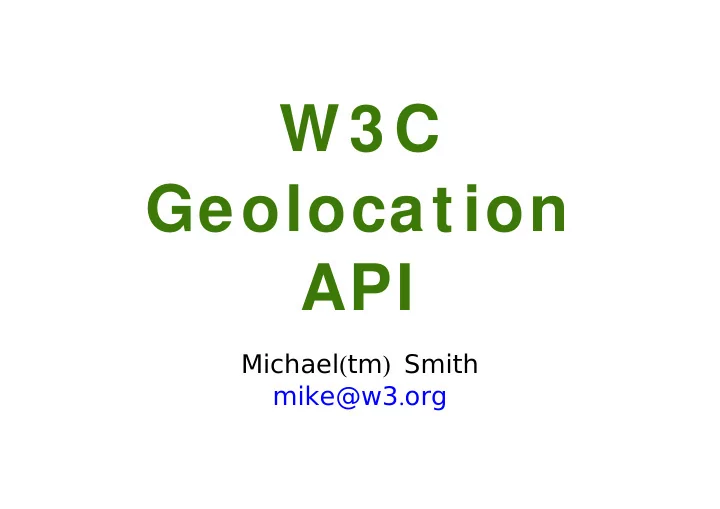

W 3C Geolocation API Michael ( tm ) Smith mike@w3 . org
Overview • API for use in W eb applications ( through JavaScript binding ) • enables Web application running on a remote server to access user location ( latitude / longitude ) data ; e . g ., for a user accessing the Web from a browser running on a mobile device ( mobile handset , laptop , etc .)
How does a W eb app get access to user location data? The API requires browser support ; either the device a browser is running on must directly expose one or more location - sensing mechanisms ( e . g ., GPS ) to the browser , or some other third - party application must expose it to the browser ( e . g ., WiFi positioning through SkyHook )
W ho ’ s doing the work? • W3C Geolocation Working Group • the editor for the spec works for Google • Google Gears has already shipped with support for the API
W here to get it http :// dev . w3 . org / geo / api / spec - source . html
Requirem ents • must provide location data in terms of a pair of latitude and longitude coordinates • must provide information about the accuracy of the retrieved location data • must support " one - shot " position updates
Requirem ents ( m ore ) • must allow an application to register to receive repeated position updates • must allow an application to cheaply query the last known position • must provide a way for the application to receive updates about errors that may have occurred while obtaining a location fix
Requirem ents ( m ore ) • must allow an application to specify a desired accuracy level of the location information • must be agnostic to the underlying sources of location inform ation • should allow an application to request address information as part of the location data
Agnostic about location m ethod • The API does not expect or depend on any particular location method . • Can work with any location - sensing m echanism exposed to the browser ; might be on GPS , IP address , RFID , WiFi , Bluetooth MAC address , GSM / CDMA cell IDs ,…
Som e use cases • Show the user's position on a map • Find points of interest in the user's area • Turn - by - turn route navigation ( like NaviTim e ) • Push alerts when points of interest are in the user's vicinity • Location - tagged status updates in social networking applications
Exam ple : “ One - shot ” query function showMap ( position ) { // Show a map centered at // at ( position . latitude , position . longitude ). } // One - shot position request . navi gat or . geol ocat i on . get Cur r ent Posi t i on ( showMap );
Exam ple : Position updates function scrollMap ( position ) { // Scrolls the map so it is centered // at ( position . latitude , position . longitude ). } // Request repeated updates . var watchId = navi gat or . geol ocat i on . w at chPosi t i on ( scrollMap ); function buttonClickHandler () { // Cancel when user clicks button navi gat or . geol ocat i on . cl ear W at ch ( watchId ); }
IDL : Geolocation interface eol ocat i on { interface G readonly attribute Position l ast Posi t i on ; void getCurrentPosition ( in Posi t i onCal l back successCallback ); … int watchPosition ( in Posi t i onCal l back successCallback ); … void clearWatch ( in int watchId ); };
IDL : PositionCallback interface interface Posi t i onCal l back { void handleEvent ( in Posi t i on position ); };
IDL : Position object interface Posi t i on { readonly attribute double l at i t ude ; readonly attribute double l ongi t ude ; readonly attribute double accur acy ; readonly attribute double altitude ; readonly attribute double altitudeAccuracy ; readonly attribute double heading readonly attribute double velocity readonly attribute DOMTimeStamp timestamp ; };
The End Thanks ! mike@w3 . org
Recommend
More recommend